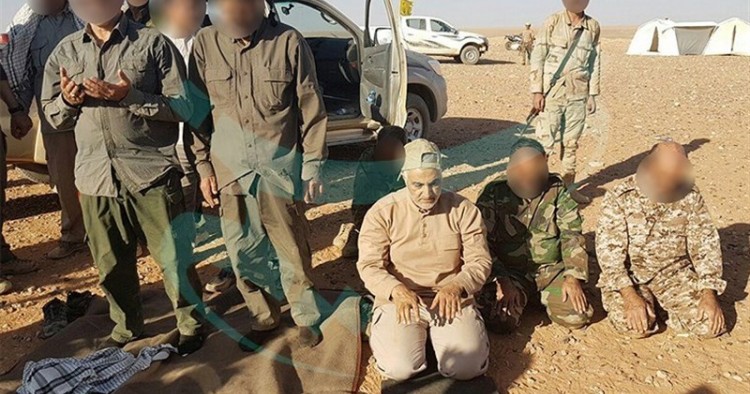Afghan Shiite militias fighting in Syria have made significant gains in military operations against the Islamic State in Deir Ezzor Province, the Iranian media reports. The commander of the militia unit, called the Fatemiyoun Division, told Tasnim News Agency, an Iranian outlet affiliated with the Islamic Revolution Guards Corps (I.R.G.C.), that Afghan militiamen, together with the Syrian Army and other Iranian-led forces, are advancing toward al-Mayadin and are within 15 kilometers of the strategic district and Islamic State stronghold in Deir Ezzor. He added that the seizure of al-Mayadin will pave the way for “resistance fighters” to ultimately reach Abu Kamal border crossing near the Iraqi border.
He emphasized that by capturing al-Mayadin and reaching Abu Kamal border crossing, Fatemiyoun combatants will fulfill the promise of Quds Force Commander Qassem Soleimani about destroying the Islamic State.
The Afghan commander claimed that Islamic State militants in the region are besieged and will be destroyed. He rejected media reports that the Syrian Army and Iranian-aligned militia forces have come under siege in the region lately.
Comment: The Afghan militia commander’s remarks refer to Soleimani’s statement late in September that the Islamic State will be defeated in Syria and Iraq within two months. “Iran, Russia, Syria, and Iraq should hold this celebration,” Soleimani said at a ceremony commemorating an Iranian soldier killed in Syria.
Iran and its allies have placed particular focus on capturing al-Tanf, a border crossing in southeast Syria along the border with Jordan and Iraq where the U.S. is training Syrian rebel forces to fight the Islamic State, as well as Abul Kamal, another border crossing in Deir Ezzor Province linking Syria to Iraq’s al-Qaim. Iran and its allies have recently sent reinforcements near the de-confliction zone in southeast Syria to pressure the U.S. military to withdraw from a strategic garrison near al-Tanf border crossing. From Tehran’s view, the expulsion of American troops from al-Tanf not only removes a long-term threat to the regime of Bashar al-Assad, but it also helps consolidate Iran’s strategic plans in Syria and the Levant region. “Liberating al-Tanf and clearing remaining areas from Daesh gives Iran access to the Mediterranean shores and northern borders of the occupied territories,” wrote Alwaght News. “There is evidence that Washington, in addition to consolidating its control over al-Tanf, is seeking to capture Abu Kamal region as well. It aims to control two strategic border crossings between Syria and Iraq after the defeat of the Islamic State. It appears that who first enters the battle with Daesh over Abu Kamal is important,” it added. Iranian-backed Iraqi Shiite militia forces are simultaneously fighting the Islamic State on the Iraqi side of the border.
The Fatemiyoun Division consists of more than 10,000 Afghan Shiite combatants recruited by the I.R.G.C. from the Afghan refugees and migrant workers living in Iran as well as Shiite Hazaras from inside Afghanistan. A senior Iranian official revealed earlier this year that 18,000 Afghan Shiites were now fighting in Syria. The all-Afghan unit has played a key role in helping Damascus and Tehran to recapture key population centers over the past years, including the city of Aleppo last December. Last year, Soleimani acknowledged that the Afghans’ participation in the Syrian conflict had been very “impactful,” and that it had also elevated the status of the Afghan refugees inside Iran. “Today, praise be to God, Afghans are looked at with a different view, different respect. Graves of Afghanistani [Afghan] martyrs are treated like the graves of imamzadeha [sons or grandsons of 12 Shiite imams],” the Quds commander explained.
According to the Iranian media, the Fatemiyoun was founded by leaders of two Afghan Shiite militant groups: Sepah-e Muhammad (Muhammad Army), an Iran-backed group that operated against the Taliban in Afghanistan in the 1990s, and the Abuzar Brigade, which fought alongside Iranian military forces against Iraq in the 1980s. The Fatemiyoun’s sister organization, the Zainabyoun Brigade, is much smaller in size and is comprised of hundreds of Pakistani Shiites.
Afghanistan’s Foreign Ministry this week called on the Iranian government to stop recruiting and sending Afghan refugees to fight in Syria, Afghan media and BBC Persian reported. Ahmad Shekaib Mostaghni, the ministry’s spokesman, raised particular concern about Afghan children deployed by the I.R.G.C. to the Syrian battlefield. He also alleged that a number of Afghan refugees in Iran are “forced or incentivized” to commit actions that run “counter to international norms.”
The Middle East Institute (MEI) is an independent, non-partisan, non-for-profit, educational organization. It does not engage in advocacy and its scholars’ opinions are their own. MEI welcomes financial donations, but retains sole editorial control over its work and its publications reflect only the authors’ views. For a listing of MEI donors, please click here.













